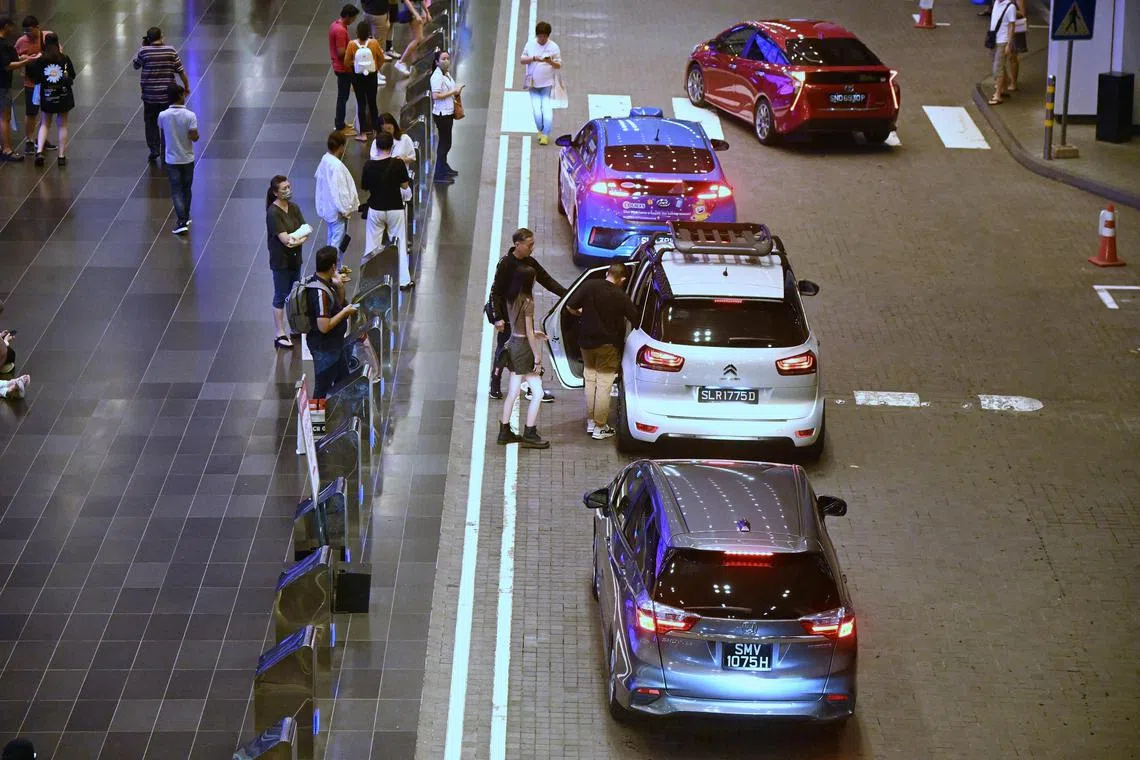Private-hire car population remains stable; less than 3% of COEs secured went to foreigners
Sign up now: Get ST's newsletters delivered to your inbox

The total private-hire car population has averaged around 70,000 since 2019.
ST PHOTO: DESMOND WEE
Follow topic:
SINGAPORE - The number of private-hire cars (PHCs) has remained stable at around 70,000 since 2019 and accounted for about 10 per cent of the total car population, Transport Minister S. Iswaran said on Monday.
He cited the figures in response to MPs who filed questions relating to high certificate of entitlement (COE) premiums, including whether the Government would consider measures to prevent private-hire companies from dominating and driving up COE prices.
In his ministerial statement, Mr Iswaran said the number of PHCs – used either to provide ride-sharing services or for car-sharing – on the road increased the fastest between 2015 and 2017, when it rose from 30,000 to almost 70,000.
During that period, there was “no commensurate upward pressure on COE prices”, he told the House. “Conversely, while COE prices have been rising over the past several quarters, demand from PHC companies has, in fact, been moderating.”
Ms Mariam Jaafar (Sembawang GRC) and Mr Yip Hon Weng (Yio Chu Kang) asked if it was possible to limit the number of cars that PHC operators can own, given the belief that such companies have the financial muscle to chase up COE premiums and edge out private car buyers.
In response, Mr Iswaran urged caution on imposing any caps, noting that the PHC industry is a relatively new development and that the Covid-19 pandemic had disrupted the market.
“We are studying this further to ascertain the effect of PHCs, if there is any impact, on the market.”
He noted that such cars are a flexible way to boost the options that people have to get around, while “serving a much wider segment of society than private cars”.
Taken together, taxis and rental cars account for around one million daily journeys now, up from 800,000 in 2012.
Ms Mariam later asked if there was no evidence that private-hire firms were driving up COE prices, noting that it was “not a level playing field”.
“They have ways to pass on higher prices. And also, you know, the ability to convert some of these PHCs into private cars, although of course, there is a market for that. So, how can we close down some of these loopholes?” she said.
Replying, Mr Iswaran reiterated the point that the number of COEs that were secured for PHCs has been moderating. “Let’s not be too quick to conclude what the causes are and therefore start fixing problems that may not really be at the root of the issue,” he said.
He noted that the sector covers various types of firms, including the likes of Grab and car-sharing companies.
“So, it is important that we understand this correctly before we decide whether there is a need to act, because they have an impact that perhaps distorts the market. And, if so, then what are those targeted measures?” he added.
In the first three months of 2023, there were 1,884 new PHCs added to the vehicle population and 443 deregistered. The net PHC population as at end-March 2023 was 74,861. This was up from the 72,632 recorded at end-2022.
Other than new vehicles that are registered as PHCs, the increase can also come from existing normal cars being converted to become PHCs for a fee. As these cars are already on the road, they would not require a fresh COE. At the same time, PHCs can also be converted to become normal cars.
Dr Lim Wee Kiak (Sembawang GRC) and Ms Joan Pereira (Tanjong Pagar GRC) asked if factors like the influx of foreign residents have contributed towards the rise in COE prices.
In response, Mr Iswaran said the proportion of car COEs secured by foreigners remains low and has not changed significantly over the years.
Between July 2020 and December 2022, on average, less than 3 per cent of car COEs were allocated to foreigners, he said, adding that the number has remained stable.
Turning to households that own more than one car, Mr Iswaran said the proportion of such households has been steadily declining, from about 19 per cent of households in 2012, to less than 15 per cent today.
He noted that as at Oct 31, 2022, about 12 per cent of the 471,000 households that own cars have two cars, while less than 3 per cent have three or more cars.
The percentages remain about the same today, he said, adding that multiple-car-owning households live across HDB flats, condominiums and landed properties.


